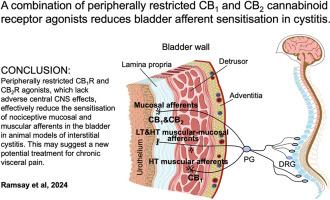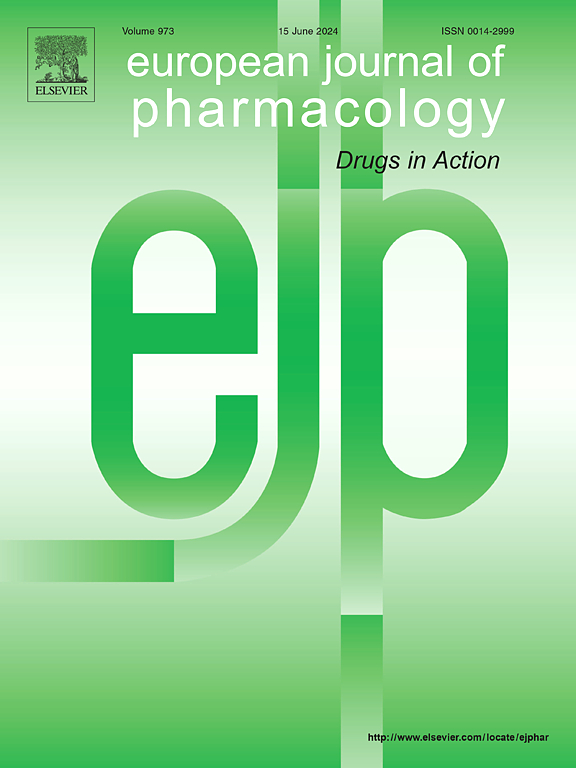A combination of peripherally restricted CB1 and CB2 cannabinoid receptor agonists reduces bladder afferent sensitisation in cystitis
IF 4.2
3区 医学
Q1 PHARMACOLOGY & PHARMACY
引用次数: 0
Abstract
Cannabinoid agonists can potentially ameliorate lower urinary tract symptoms (LUTS), including pain associated with interstitial cystitis/bladder pain syndrome (IC/BPS). This study aims to determine the contributions of the cannabinoid 1 receptors (CB1Rs) and CB2Rs in regulating the activity of different functional classes of afferents, comparing normal healthy bladder with bladders from guinea pigs with protamine/zymosan-induced cystitis. The mechanosensitivity of different functional afferent classes was determined by ex vivo single-unit extracellular recordings.
Peripherally restricted CB1R preferential agonists, ACEA and PrNMI and peripherally restricted CB2R selective agonists, 4Q3C and olorinab all reduced the mechanosensitivity of mucosal bladder afferents. The potency and efficacy of these synthetic cannabinoid agonists were significantly increased in cystitis compared to controls. Combined application of CB1R agonists, ACEA or PrNMI with the CB2R agonist, 4Q3C produced additive inhibitory effects. ACEA and PrNMI also inhibited the stretch-induced firing of high-threshold muscular bladder afferents in animals with cystitis. In contrast, low- and high-threshold muscular-mucosal bladder afferents were unaffected by the CB1R and CB2R agonists in control and cystitis. Our data indicated that peripherally restricted CB1R and CB2R agonists effectively reduce the sensitisation of probable nociceptive afferents in the bladder in cystitis. The findings also suggest a potential benefit of simultaneously targeting both the CB1Rs and CB2Rs to ameliorate LUTS in cystitis.

外周限制性 CB1 和 CB2 大麻受体激动剂组合可降低膀胱炎的膀胱传入敏感性。
大麻素激动剂有可能改善下尿路症状(LUTS),包括与间质性膀胱炎/膀胱疼痛综合征(IC/BPS)相关的疼痛。本研究旨在通过比较正常健康膀胱与原胺/zymosan诱发膀胱炎的豚鼠膀胱,确定大麻素1受体(CB1Rs)和CB2Rs在调节不同功能类别传入神经活动中的贡献。通过体外单体胞外记录确定了不同功能传入类的机械敏感性。外周限制性 CB1R 首选激动剂 ACEA 和 PrNMI 以及外周限制性 CB2R 选择性激动剂 4Q3C 和 olorinab 都降低了膀胱粘膜传入的机械敏感性。与对照组相比,这些合成大麻素激动剂在膀胱炎患者中的效力和疗效显著提高。将 CB1R 激动剂 ACEA 或 PrNMI 与 CB2R 激动剂 4Q3C 联合应用可产生相加的抑制作用。ACEA 和 PrNMI 还能抑制膀胱炎动物高阈值膀胱肌肉传入的拉伸诱发点燃。相比之下,在对照组和膀胱炎动物中,低阈值和高阈值的膀胱粘膜肌肉传入神经不受 CB1R 和 CB2R 激动剂的影响。我们的数据表明,外周限制性 CB1R 和 CB2R 激动剂能有效降低膀胱炎患者膀胱中可能的痛觉传入的敏感性。研究结果还表明,同时靶向 CB1R 和 CB2R 有助于改善膀胱炎患者的尿失禁症状。
本文章由计算机程序翻译,如有差异,请以英文原文为准。
求助全文
约1分钟内获得全文
求助全文
来源期刊
CiteScore
9.00
自引率
0.00%
发文量
572
审稿时长
34 days
期刊介绍:
The European Journal of Pharmacology publishes research papers covering all aspects of experimental pharmacology with focus on the mechanism of action of structurally identified compounds affecting biological systems.
The scope includes:
Behavioural pharmacology
Neuropharmacology and analgesia
Cardiovascular pharmacology
Pulmonary, gastrointestinal and urogenital pharmacology
Endocrine pharmacology
Immunopharmacology and inflammation
Molecular and cellular pharmacology
Regenerative pharmacology
Biologicals and biotherapeutics
Translational pharmacology
Nutriceutical pharmacology.

 求助内容:
求助内容: 应助结果提醒方式:
应助结果提醒方式:


